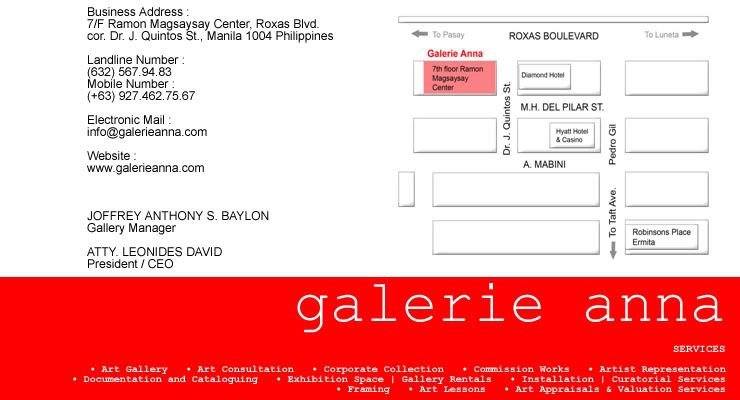
SOCIETY has been exposed to the creation of abstract art since people have existed, but recognizably, there are varying "levels" of abstraction. Depending on the degree of abstraction, the artist has to discover more ingenious ways of conveying that precise concept. At an instance in humans’ early history, cave walls became the canvasses of men and women who drew scenes of hunting, of their flourishing bounty, of race, moment and milieu. Contemporary painters, such as Jackson Pollock, articulated emotions and pure concepts on canvas. Because his work has been inclined to focus around the notion of order within chaos, Pollock is an eminent paradigm. The perception of victory or success in hunting has to be easier to express than the notion of orderly chaos. With more involved "subjects", the form of expression itself has to become flexible. Thus, the significance of abstract art.
In his essay Roots of Diversity in Philippine Contemporary Art, artist/writer/curator Ronald Hilario noted that “The early 1950's saw the triumph of the modernists over the conservatives. Thanks to the efforts of Lyd Arguilla of the Philippine Art Gallery in showcasing the art of the young modernists, abstraction gained a stronger foothold and soon became the dominant style. More informed in the aesthetics of cubism, surrealism, and expressionism, these young artists expanded the concern of Philippine visual arts from style to a broader exploration of the formal elements of visual art. The first non-representational paintings and sculptures appeared at this stage, and were developed to a higher level by the third wave of artists who came in during the 1960's to the 1970's. Some of the more active artists in this period were Vicente Manansala, Napoleon Abueva, Jose Joya, Cesar Legaspi, Arturo Luz, and Fernando Zobel. Texts on abstract art became more available to artists in the 60's. Modernist art theories were introduced and taught in the Philippine Fine Arts Schools by academics and artists such as Rod Paras Perez and Roberto Chabet. Readings of these texts paved the way for a more cerebral approach to art making. Conceptual Art, Minimalism, and Performance Art made their debut in the country. Artists also became more vocal about their works and some published their ideas in art journals such the Philippine Supplement in the 70's. The Marcos regime's patronage of the arts added muscle to many artists' projects. The Cultural Center of the Philippines (CCP), the centerpiece of the First Lady Imelda Marcos' cultural program, was established and became the home of non-objective art. During the tenure of artist-curators Ray Albano and Roberto Chabet the CCP galleries were sites of numerous abstract art exhibitions and performances. At the forefront of these activities were Ray Albano, Gus Albor, Roberto Chabet, Mars Galang, Ben Maramag, Lee Aguinaldo and David Medalla.”
Modern art has usually been characterized by its inventiveness, and within this parameter, critics have looked to formal innovation to classify artworks in relation to their time, rather than place of origin. The nonrepresentational contemporary art that critics have made canonical was concerned with universal and transcendent aims, or with rendering concepts.
The title implies urgency, not the haphazard approach for art’s sake, but of the manner by which the artwork impacts on the viewer. It is the resultant realization when the message of the abstraction has been deciphered, and in this instant, that dawning comes charging fifteen times over. That ensuing speed, that consequential rush impinging on the cerebral, in a flash engulfs the aficionado.
This exhibition features drawings, paintings and sculptures – significant pieces designed to visually expound important concepts about abstraction and its history in a non-threatening manner copulated with the dynamic relationship between discourses, forms, and styles. From the deceased to the emergent, the artists in this exhibition were all vital to producing the FLASH, a uniquely positioned showcase of Philippine Abstraction.
Ross Capili, Danilo Garcia, Andrew de Guzman, Fitz Herrera, Raul Isidro, Alfredo Liongoren, Sio Montera, J Elizalde Navarro, Eghai Roxas, Hermi Santo, Sherwin Tan, Roy Veneracion, Phililip Victor, Javy Villacin and Nestor Olarte Vinluan.
FLASH! Fifteen Filipino Abstractionists shall be on view starting October 18, 2008 at Galerie Anna, 7th floor, Ramon Magsaysay Center, Roxas Boulevard corner Dr. J. Quintos Street, Manila 1004 Philippines. For more information and queries about the gallery and the exhibition, you can log on to www.galerieanna.com, contact Gallery Manager Mr. Joffrey Baylon at landline number (632) 5679483, or email at info@galerieanna.com.



















































































































































































No comments:
Post a Comment